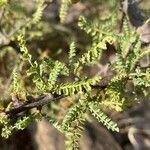A much-branched or spreading shrub or tree 2–6 m. high; bark smooth, grey reddish, scaling off in papery strips; root-bark densely brown woolly; branchlets rough and with lenticels or glabrous and scaling off.. Leaves 7–15-foliolate, crowded on the short floriferous lateral branchlets or alternating on the branchlets, 1.5–5 cm. long; rachis narrowly and usually interruptedly winged, sparsely stellate-pubescent or puberulent; leaflets obovate, 2–10 mm. long and broad, incise-crenate halfway towards the apex, emarginate or obtuse at the apex, lateral ones with obtuse base, the terminal one with narrowly cuneate base, sessile or subsessile, glabrous except the midrib which has scattered stellate hairs, coriaceous; midrib and the lateral nerves somewhat impressed on both surfaces.. Inflorescences spike-like, l–4 cm. long, clustered on short lateral branchlets and mixed with the leaves; axis densely whitish stellate-tomentose; bract 1 mm. long; pedicel 0.5–2 mm. long.. Calyx-lobes ovate, ± 0.4 mm. long and broad, pubescent.. Petals 1–1.3 mm. long and broad, ciliate on the margin, whitish.. Drupes rounded or ovoid, 9–14 mm. long, 9–11 mm. in diameter, green with a red bloom, glabrous, fleshy and edible.
More
A spreading tree. It has many branches. It loses its leaves during the year. It can grow up to 4 m high. The branches are drooping. The bark is dark grey and smooth. The base of the stem often has a thread like growth over it. The leaves are divided into small leaflets. These have blunt teeth near the tip. The leaves are clustered on short shoots. The leaf stalk is often winged. The flowers are on flowering shoots amongst the leaves. They are small and greenish-yellow. The fruit are 2 cm across. They are green but turn orange when ripe. The seeds are green and have a rough surface.
A tropical plant. In Kenya it grows on rocky hillsides between sea level and 1,200 m altitude. It is in areas with a rainfall between 400-600 mm per year. It suits dry land. It can grow in arid places.
More
Dry Acacia, Commiphora bushlands; rocky outcrops and hill slopes; coastal forest edges; at elevations from sea level to 1,200 metres. The plant is locally common and can form pure stands.



